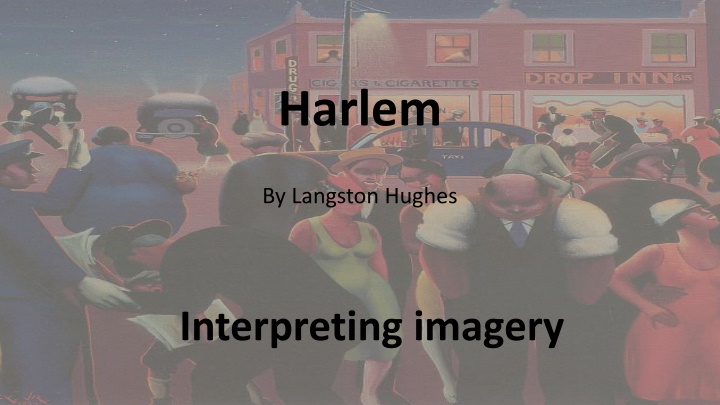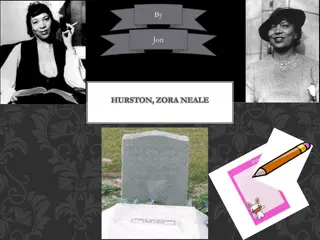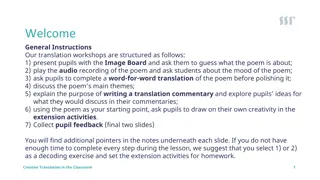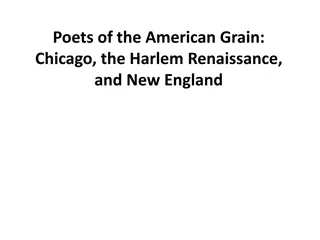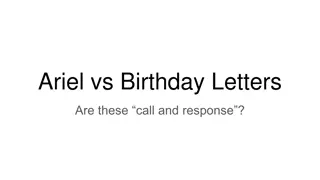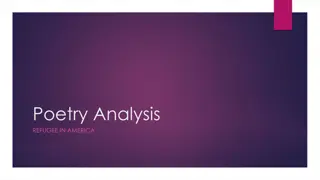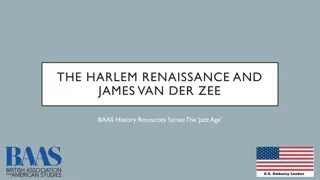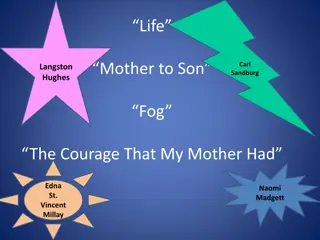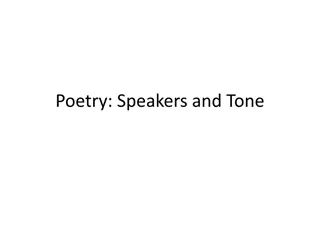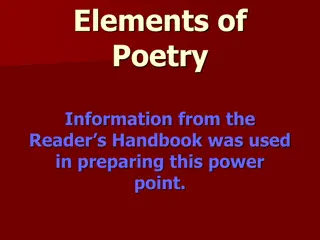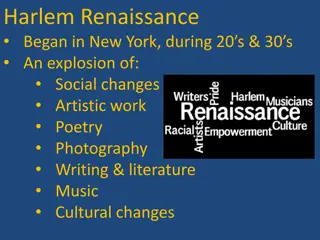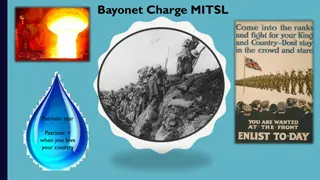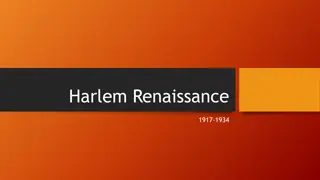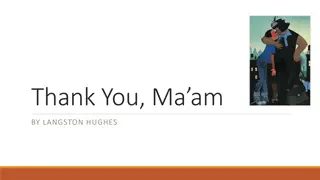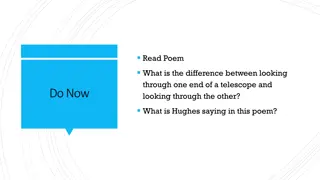Analyzing Imagery in Langston Hughes' "Harlem" Poem
Langston Hughes' poem "Harlem" explores the consequences of deferred dreams through vivid imagery. The poem contemplates various outcomes of postponed aspirations, evoking themes of frustration, decay, and explosive potential. By dissecting the powerful imagery used in the poem, readers gain insight into the profound impact of unfulfilled dreams on individuals and communities.
Download Presentation

Please find below an Image/Link to download the presentation.
The content on the website is provided AS IS for your information and personal use only. It may not be sold, licensed, or shared on other websites without obtaining consent from the author.If you encounter any issues during the download, it is possible that the publisher has removed the file from their server.
You are allowed to download the files provided on this website for personal or commercial use, subject to the condition that they are used lawfully. All files are the property of their respective owners.
The content on the website is provided AS IS for your information and personal use only. It may not be sold, licensed, or shared on other websites without obtaining consent from the author.
E N D
Presentation Transcript
Harlem By Langston Hughes Interpreting imagery
Langston Hughes Historical Background Historical Background Harlem was written in 1951 Harlem was written in 1951 Addresses the limitations on the Addresses the limitations on the access to the American Dream for access to the American Dream for African Americans African Americans
Learning Objectives: Understand the literal meanings of imagery Analyze and interpret the effects of imagery on a piece of writing Distinguish between paraphrasing and interpretation Use textual evidence to support a claim, interpreting its effects
Harlem by Langston Hughes What happens to a dream deferred? What happens to a dream deferred? Does it dry up Does it dry up like a raisin in the sun? like a raisin in the sun? Or fester like a sore Or fester like a sore And then run? And then run? Does it stink like rotten meat? Does it stink like rotten meat? Or crust and sugar over Or crust and sugar over like a syrupy sweet? like a syrupy sweet? Maybe it just sags Maybe it just sags like a heavy load. like a heavy load. Or does it explode? Or does it explode? How does the author use imagery to convey the How does the author use imagery to convey the sense of longing in the poem? sense of longing in the poem?
Paraphrase: Retell in your own words What happens to a dream deferred? What happens to a dream deferred? Does it dry up Does it dry up like a raisin in the sun? like a raisin in the sun? Or fester like a sore Or fester like a sore And then run? And then run? Does it stink like rotten meat? Does it stink like rotten meat? Or crust and sugar over Or crust and sugar over like a syrupy sweet? like a syrupy sweet? Maybe it just sags Maybe it just sags like a heavy load. like a heavy load. Or does it explode? Or does it explode? What is the literal meaning behind each use of imagery? Use your foldable to paraphrase each use of imagery.
With a partner, paraphrase each line of imagery What happens to a dream deferred? What happens to a dream deferred? What happens when a goal is put off indefinitely? Does it dry up Does it dry up Does it wither and shrink? like a raisin in the sun? like a raisin in the sun? Or fester like a sore Or fester like a sore Does it rot as an open sour and drip pus and blood? And then run? And then run? Does it stink like rotten meat? Does it stink like rotten meat? Will it spoil and give off a bad smell? Or crust and sugar over Or crust and sugar over Does it get stale like a dessert? like a syrupy sweet? like a syrupy sweet? Maybe it just sags Maybe it just sags Does it bend from its own weight? like a heavy load. like a heavy load. Or does it explode? Or does it explode? Or does it burst?
Using and interpreting textual evidence Now that you understand the literal meaning of the poem: You ve got plenty of evidence! But how do we explain and link?
interpret: Analyze and draw a conclusion What happens to a dream deferred? What happens to a dream deferred? Does it dry up Does it dry up like a raisin in the sun? like a raisin in the sun? Or fester like a sore Or fester like a sore And then run? And then run? Does it stink like rotten meat? Does it stink like rotten meat? Or crust and sugar over Or crust and sugar over like a syrupy sweet? like a syrupy sweet? Maybe it just sags Maybe it just sags like a heavy load. like a heavy load. Or does it explode? Or does it explode? What is the author actually trying to convey with each use of imagery? What is the message the author intends to communicate? Use your foldable to interpret each use of imagery.
With a partner, interpret the meaning behind the imagery. Are goals and dreams really achievable in our current society? What happens if the answer is no? What happens to a dream deferred? What happens to a dream deferred? Does it dry up Does it dry up Raisins come from juicy grapes. Does the dream wither and slowly die? like a raisin in the sun? like a raisin in the sun? Will the dream just remain a sickly version of itself that never heals, that just slowly seeps pain? Or fester like a sore Or fester like a sore And then run? And then run? Rotten meat is harmful garbage that must be thrown away for for health reasons. Does it stink like rotten meat? Does it stink like rotten meat? Or crust and sugar over Or crust and sugar over Sweet treats become stale when left out, neglected, contrasting a sweet promise of a dream with the bitterness of lost dreams. like a syrupy sweet? like a syrupy sweet? Maybe it just sags Maybe it just sags The burden of the unfulfilled dream weighs on the dreamer over time, and the effects can be physically felt. like a heavy load. like a heavy load. Or does it explode? Or does it explode? Explode has two connotations: Dangerous and celebratory. Which will it be?
How does the author use imagery to convey the How does the author use imagery to convey the sense of longing in the poem? sense of longing in the poem? Use your interpretations to answer the question using P.E.E.L.
Explaining your textual evidence: Explaining your textual evidence: In the poem Harlem, Langston Hughes uses imagery to convey a theme of longing for unfulfilled dreams. He asks, Does it sag like a heavy load? This means that an unfulfilled dream can can bend under it s own weight. We can therefore see the physical effects of a dream that is neglected over time. Which explanation is more Which explanation is more effective? effective? COMPARE COMPARE In the poem Harlem, Langston Hughes uses imagery to convey a theme of longing for unfulfilled dreams. He asks, Does it sag like a heavy load? This means that an unfulfilled dream weighs on the dreamer over time, and its effects can be phycically felt. We can therefore see the physical effects of a dream that is neglected over time.
Compare your paraphrasing to your Compare your paraphrasing to your interpretations. Which are more effective? interpretations. Which are more effective? In the poem Harlem, Langston Hughes uses imagery to convey a theme of longing for unfulfilled dreams. He asks about the dream, Does it explode? This means that eventually the dream could burst. The reader must question if a neglected dream will eventually explode. COMPARE COMPARE In the poem Harlem, Langston Hughes uses imagery to convey a theme of longing for unfulfilled dreams. He asks about the dream, Does it explode? This question has two connotations: both dangerous and celebratory. The reader must explore the possible outcomes of long neglected dreams, how they have the potential to be victorious or violent. How does paraphrasing limit your ability to analyze the poem?
